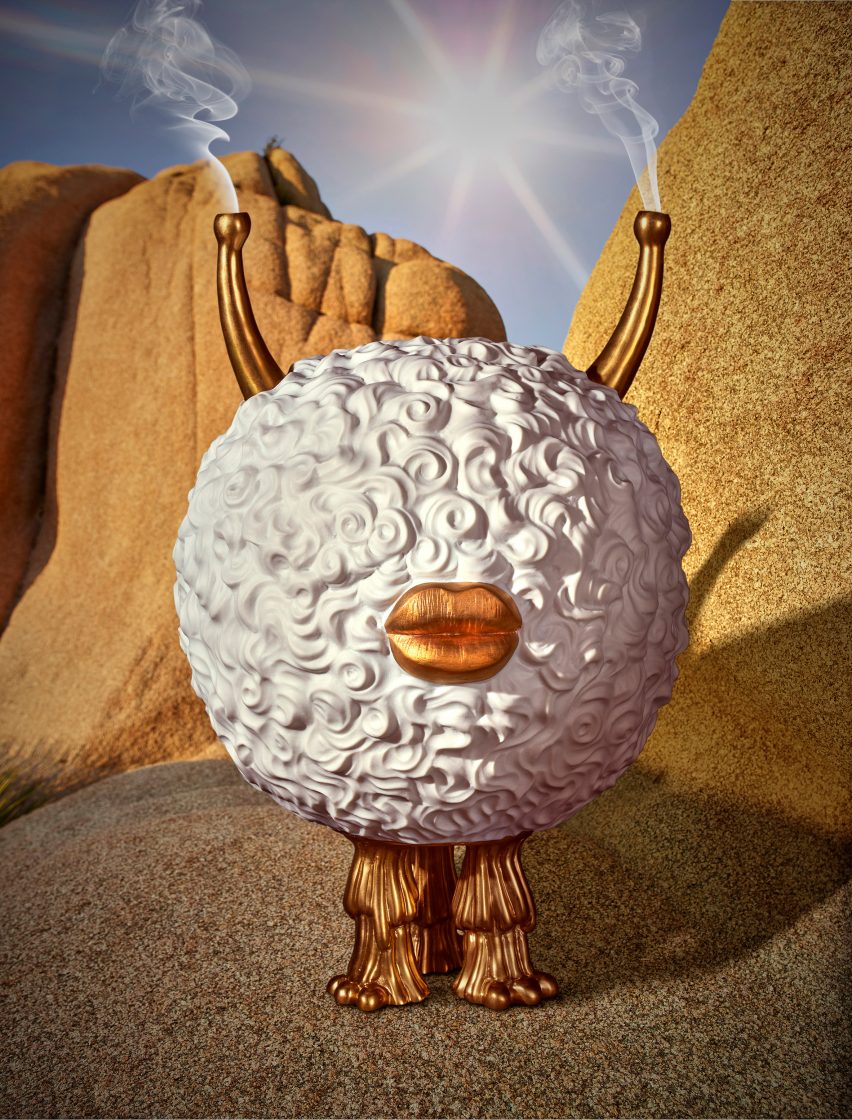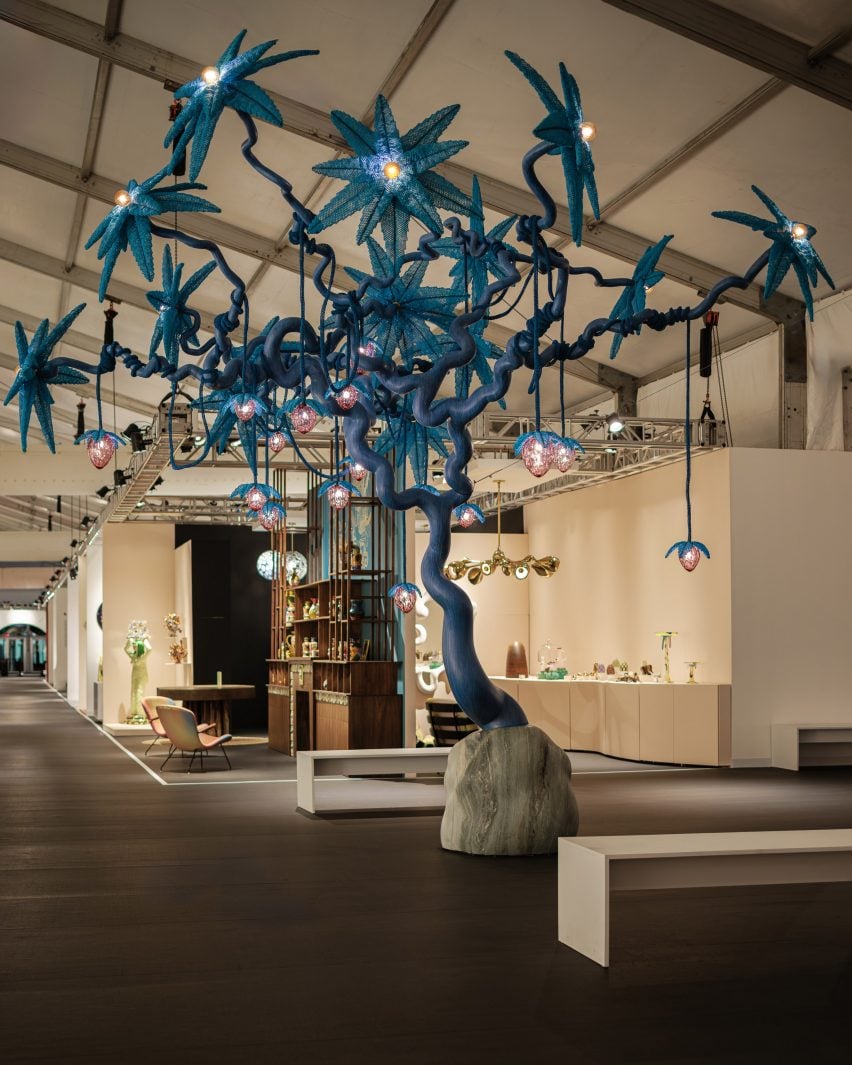[ad_1]
This year’s Design Miami was characterised by experimental work, but that wasn’t always the case at the fair, art-design duo the Haas Brothers tell Dezeen in this exclusive interview.
By embracing the avant-garde, galleries and designers at Design Miami have begun to carve out a style that blurs the boundaries between design and art, according to twins Simon and Nikolai Haas.
“It’s a total movement, and it’s very recognisable,” said Simon Haas. “In the last 10 years, the trajectory at Design Miami is clear – and that defines a movement.”
“I see the work at Design Miami as its own subset in the creative world,” added Nikolai Haas.

The Haas Brothers referenced designers like Misha Kahn and forerunners such as Wendell Castle, as well as galleries such as Carpenters Workshop Gallery, Southern Guild and The Future Perfect.
They said the fair has been increasingly becoming more experimental and allowed makers to push the boundaries of what could be shown there.
The brothers are known for their fantasy-laden works, including a series of furniture and sculptures based on the 1992 animated film Ferngully and a collection of alien-like objects with tentacles made from porcelain accretions.
“We’ve always pushed what can be shown”
“Design Miami was our first market and we’ve always pushed what can be shown there, to the point where one year we almost got kicked out of Design Miami because they said the work wasn’t ‘design’ – and, fair enough, it wasn’t,” said Nikolai Haas.
“We understood that pushing boundaries was a relevant conversation and now, the fact that the Nasher has commissioned five large-scale sculptures feels like a stamp of approval on the art side,” he added. “Now we’re moving in both directions.”

For this year’s Design Miami collectible furniture fair in Miami Beach, the twins showcased a massive bronze tree on a stone pedestal, crowned with petals made from thousands of Venetian beads woven together by a group of craftspeople in California using a biophilic system devised by Simon Haas.
The piece was originally commissioned by the Nasher Sculpture Center in Dallas, and represents, for the Haas Brothers, a “stamp of approval” for their aesthetic to move between art and design.
The pair say that their style has evolved alongside work that first coalesced at Design Miami a decade ago, taking advantage of the increasingly experimental nature of the fair.
“Decadent without being wasteful”
According to the designers, this experimental style pays homage to design tendencies while also embracing a playful approach to modern materials that have become more widespread.
“It’s using design as a jumping-off point to express yourself in the same way that you would express yourself with a painting,” said Simon Haas.
“And I don’t really see the difference, honestly, except that you get to live with and use the piece of art in this sphere, and that’s how I like to interact with art anyway.”
“I’ll say it’s decadent without being wasteful, like an ornate early-modern Italian house,” he added.
Having a function is often identified as the key distinguishing feature between design and art, but the Haas brothers seek to challenge conventional ideas of practical use.
“Cuteness is functional,” argued Simon Haas. “For example a baby is pretty difficult to deal with, and a puppy is hard to deal with. But the cuteness makes you want to take care of it.”
The Haas Brothers, who have backgrounds in design and carpentry, are known for their sculptural works that are often infused with colour and figurative.
Read on for the full, edited interview with the Haas Brothers:
Ben Dreith: This year you brought one of your works, The Strawberry Tree, from Nasher Sculpture Center into Design Miami. How does this represent a capstone moment in your attempts to bridge design and art?
Nikolai Haas: Design Miami was our first market, and we’ve always pushed what can be shown there. To the point where one year we almost got kicked out of Design Miami because they said the work wasn’t “design” – and, fair enough, it wasn’t. We understood that pushing boundaries was a relevant conversation and now, the fact that the Nasher has commissioned five large-scale sculptures feels like a stamp of approval on the art side. Now we’re moving in both directions.
Simon Haas: We missed being here too. When there was a risk of us getting kicked out of the fair, I will say that Design Miami championed us and made sure we stayed in. I think everyone together was very interested in creating a movement.
Ben Dreith: It’s funny, there is a street here that separates Design Miami from Art Basel, and it feels like you two are waltzing across it.
Nikolai Haas: Wherever the centre of our spectrum might be, Design Miami will always be the home base. It’s its own solar system.
Simon Haas: What’s cool about both of these fairs is they’re a testing ground for galleries. It’s experimental.
Ben Dreith: And by experimenting with the boundaries of art and design at Design Miami, do you think you and others have created a movement separate from “art” or “design” more generally?
Simon Haas: Exactly. It’s a total movement, and it’s very recognisable. In the last 10 years, the trajectory at Design Miami is clear – and that defines a movement.
Nikolai Haas: Design Miami has been around for 20 years. The first 10 were more about collectible, historical works. But now, the contemporary work has become so much more experimental. Everyone is in [Design Miami] saying “functional sculpture”. I understand the wording, call it whatever you want. However, I see the work at Design Miami as its own subset in the creative world.
Ben Dreith: What are some attributes of this movement you’re tracing?
Simon Haas: Paying homage to design, even if it’s abstract, while focusing on the emotional impact of a piece of furniture. It’s not pushing the boundary between art and design. It’s using design as a jumping-off point to express yourself in the same way that you would express yourself with a painting. And I don’t really see the difference, honestly, except that you get to live with and use the piece of art in this sphere, and that’s how I like to interact with art anyway. I’ll say it’s decadent without being wasteful, like an ornate early modern Italian house. It lasts.
Nikolai Haas: The work will last. We build with the front end as expensive as possible, in a way that will be absolutely impossible even in 2030. This happens all the time, for example, mid-century buildings used a lot of cast concrete but now this is considered a decadent thing, using so much concrete. This can’t ever exist again. For us, it’s about about capturing this moment and preserving it in the work. Everyone’s gonna look back at this and be like, ‘Wow that was a wild moment in time’. I do think it has a defining aesthetic, and the people here are riffing off of each other to further define it.
Simon Haas: If I were to make a comparison, I’d say it’s like Art Nouveau.
Ben Dreith: There is a lot of figurative work, which reminds me of the decadent work of the early 19th century. Do you really consider the work decadent?
Simon Haas: We’ve reached a place where we have the luxury of having had modernist materials for a long time now and now we get to play with them. For example, modern buildings today don’t have the same magic that the gorgeous modern steel structures had, because they were experimental then. I think now furniture design is entering a more experimental place, where we have access to every kind of material. It’s definitely decadent. But what’s nice about periods of decadence is that art and design flourish. If stuff gets tight then we can’t afford to build stuff in the same way. That’s what’s beautiful about design, to me, is that this spectrum. It’s not form versus function, it’s how flexible you can be with the spectrum of decadence.
Ben Dreith: Is there any one material that you’ve seen that’s driving some of the material experimentations you spoke about?
Simon Haas: I’d say YouTube, actually, because it’s not just the material, it’s the easy access to information and finding out how to make something. I have watched YouTube tutorials on how to crochet, and so now I crochet.
Ben Dreith: Many people would say that this work shouldn’t be considered design because it doesn’t function in a way that relates to everyday people. However, I often think that function can go beyond the body. Cross-culture exchange, for example, is a function of collaborative design at times. How do you think about function?
Simon Haas: Cuteness is functional, for example: a baby is pretty difficult to deal with, and a puppy is hard to deal with. But the cuteness makes you want to take care of it. So it’s serving a purpose. Beauty does the same thing. Sometimes we use function as a punchline.
Nikolai Haas: For the Strawberry Tree, the problem was creating work in a place that has no studio space by having a community in California help to assemble the complicated beadwork. We could send a tote bag with beads and string, and someone could use that and take it and make parts for us to assemble into something much larger. The function was to make work available in any place, at any time. We also try and make work to be engaged with. Now that we’ve been a part of it for a while, you start to see other artists that are striving to use function in their work, and they’re very inelegant at it, because they haven’t been doing it like the rest of us have.
Ben Dreith: In places like Design Miami and Art Basel, inaccessible from a financial point of view, the design/art divide seems most important to marketing.
Simon Haas: The market is the main definer. Function versus form comes up all the time, but the truth is, we don’t care all that much.
Ben Dreith: Who are some other people who define this movement and moment of design art? Maybe we can call it De-Art?
Simon Haas: I like that. I’d say, Mischa Kahn. Humans Since 1984 are good examples.
Nikolai Haas: Wendell Castle was a forefather of this. David Weissman, he’s more on the decorative side. Campana Brothers. And also the galleries, Southern Guild, Carpenters Workshop, Future Perfect, Fumi. They almost invented it out of thin air.
The top photo is by Magda Wosinska.
Design Miami took place from 3 to 8 December. For more global events in architecture and design visit Dezeen Events Guide.
[ad_2]
Source link

